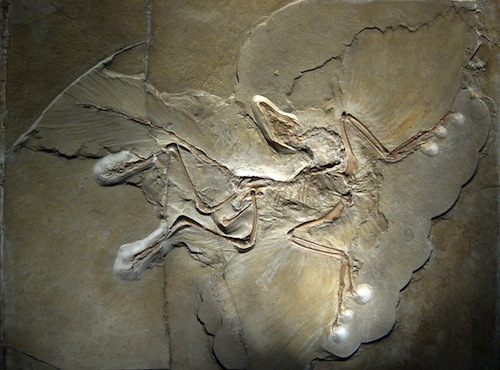 Evolution
Evolution
Archaeopteryx Reclassified as a Different Kind of Evolutionary Icon?

Archaeopteryx has long been celebrated as an evolutionary icon, representing a presumed transition from dinosaurs to birds. The creature has even inspired a product line of handsome but pricey outdoor clothing, Arc’teryx, which I’ve admired longingly at REI but never been able to justify the expense of purchasing. The company’s website explains the name:
Named for ARCHAEOPTERYX LITHOGRAPHICA, the first reptile to develop the feather for flight, freeing itself from the constraints of the horizontal world.
At Arc’teryx our central purpose is to build the finest products possible.
Unfortunately, it looks like Archaeopteryx may have to be reclassified as a different sort of icon — symbolizing evolution by loss of function. Nature reports:
Although it has long been debated whether the proto-bird Archaeopteryx was able to actually fly or merely evolving toward that ability, to date nobody had yet seriously suggested that it could have been instead in the midst of losing its ability to fly. But that is precisely what Michael Habib, a biologist at the University of Southern California proposed last week to a packed hall at the annual meeting of the Society of Vertebrate Paleontology in Los Angeles.
With the skeleton of a dinosaur and the feathers of a bird, Archaeopteryx has long been hailed as marking the transition from dinosaurs to birds.
The idea that it was instead evolving to lose its flight and becoming flightless again, or ‘secondarily flightless’, occurred to Habib while he was calculating limb ratios and degrees of feather symmetry in Archaeopteryx, and comparing the values to those of living birds, to better understand its flying ability. In doing so, he found that the creature’s traits were surprisingly similar to those of modern flightless birds such as rails and grebes that frequently dwell on islands.
"We know Archaeopteryx was living on an archipelago during the Jurassic. And with its feathers and bones looking so much like modern flightless island birds, it just makes me wonder," says Habib.
Oh, now that’s got to be a bit of a disappointment. Far from "freeing itself from the constraints of the horizontal world," it sounds more like Archaeopteryx was in the process of rejoining the world of creatures bound to the earth.
Evolution by loss of function, in this case flight, is something that no one doubts.
It’s explaining the gain of new function, in the absence of intelligent design, that remains the shimmering, ever receding mirage toward which Darwinian theory continuously, wearily, hopelessly trudges.
Image source: Archaeopteryx lithographica (Berlin specimen)/Wikipedia.
